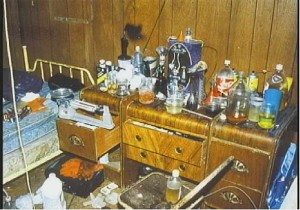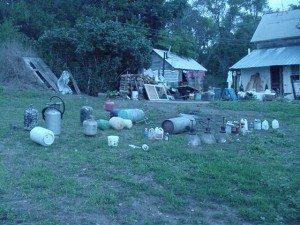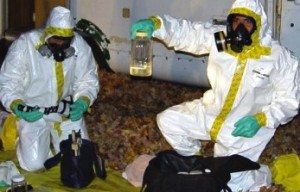Shutting down meth labs may put an end to their social harm, but their toxic residues remain.
by Mary Elizabeth Williams-Villano, LuxEco Editorial Assistant and author of the Resplendent Repurposing series
We’re all familiar by now with the scourge of crystal methamphetamine addiction and the high toll it takes: The ruined lives, the abused and neglected children, the prisons full to bursting. It’s a huge social problem for which there is no easy answer. Many lives have been and are being impacted by one of the most addictive substances known to mankind. (For a visual jolt, do a search on “faces of meth, before and after,” or “meth mouth pictures.”) Worse still, it’s a drug that people can make themselves from a simple recipe using common household chemicals. We’ve also all heard about the dangers of doing just that – the meth lab explosions and fires that have killed or maimed many. But after the fires are put out and the social toll is assessed, there is another victim that meth leaves in its wake, and that is our Earth. As if those of us who are concerned about toxic chemicals in our environment didn’t have enough things to worry about, we must now add methamphetamine lab sites, either currently operating or long closed down, to the list. The inconvenient truth is that you could be living in a former meth lab right now. Or parked next to a current one.
The manufacture of meth involves several different chemicals, nearly all of them toxic to humans and animals. The roll call includes anhydrous ammonia, iodine crystals, ether, sodium hydroxide (drain cleaner), sulfuric (battery) acid, red phosphorus, paint thinner, freon, toluene (brake cleaner), benzene, acetone and reactive metals such as lithium and sodium. Pseudoephedrine pills are also part of a meth maker’s recipe.
These chemicals are combined and “cooked” over an ordinary stove or Bunsen burner, releasing highly toxic fumes. More recently, a simpler method known as “shake and bake meth” has come along that requires no cooking at all: One merely combines chemicals in a container and shakes them together as the name suggests. It’s so easy to do that meth cooks can do it inside a car. Both methods are extremely dangerous and can result in explosion and fire.
 But a meth lab doesn’t have to blow up in order to become a disaster to people, property and the environment. The cooking process releases a cloud of toxic chemicals and compounds, including hydrocloric acid, phosphorus and iodine. When meth has been cooked — or even smoked — in a structure, the residues seep into floors, walls, carpeting, furniture and ventilation ducts. Since the chemical waste products are often dumped on-site, they also seep into soil and groundwater. For every pound of meth produced, five to seven pounds of toxic waste are left behind. The cost of cleanup of former meth lab sites to cities and property owners ranges from $2,000 to $15,000 or more.
But a meth lab doesn’t have to blow up in order to become a disaster to people, property and the environment. The cooking process releases a cloud of toxic chemicals and compounds, including hydrocloric acid, phosphorus and iodine. When meth has been cooked — or even smoked — in a structure, the residues seep into floors, walls, carpeting, furniture and ventilation ducts. Since the chemical waste products are often dumped on-site, they also seep into soil and groundwater. For every pound of meth produced, five to seven pounds of toxic waste are left behind. The cost of cleanup of former meth lab sites to cities and property owners ranges from $2,000 to $15,000 or more.
Just how dangerous are these chemicals? At the very least, exposure to meth residues left behind from cooking or smoking may cause symptoms similar to those experienced by meth users – a “contact high” if you will. At the very worst, they can cause cancer — or sudden death. Exposure to volatile organic compounds (VOCs) like those produced by meth manufacture has been known to cause headaches, dizziness, confusion, nose and throat irritation, nausea, vomiting, difficulty breathing – and worse. Benzene, a VOC often used in the cooking process is a well-known carcinogen. Coming in contact with acids or bases will cause burns to mucous membranes and skin and can severely damage the eyes. Exposure to metals and salts or their fumes can cause decreased mental function, respiratory irritation, anemia, kidney and liver damage. Police officers who have entered meth labs and experienced short-term high exposure to these chemicals have suffered severe health problems including lung damage and burns. In an April 28, 2010 story in Scienceline, Stan Smith, a UCLA doctoral student and director of CA’s Drug Endangered Children Task Force stated that: “Ingesting some of these chemicals, even a tiny drop, can cause immediate death.”
These toxins are particularly dangerous to young children and fetuses. Kids are especially sensitive to chemical exposure, which can damage developing brains. Babies and toddlers who crawl and put everything in their mouths can easily pick up meth residues. Mothers exposed to these chemicals can give birth to babies with developmental delays and other birth defects.
 The newer “shake and bake” method is particularly alarming to law enforcement officials — and should also be to us in the Green community. How many times have we picked up recyclable litter by the side of the road? Well, just such an act of practical environmental activism could now cause a person grave injury. In a June, 2010 story reported by Birmingham, Alabama’s CBS Channel 42 News, officials warned the public not to pick up plastic jugs found along roadsides. A woman who was cleaning up litter came close to being burned by one. “If it’s got little black specks in it…that’s lithium. Sudden movement could ignite it, or water getting into could blow it up, too,” stated Agent Charles Tidwell of the Walker County Drug Task Force. “A bottle like this is like half a stick of dynamite.” Coffee filters, tubes taped to bottle tops or punctured cans of starter fluid nearby are other giveaways that litter could be the deadly detritus of a mobile meth lab.
The newer “shake and bake” method is particularly alarming to law enforcement officials — and should also be to us in the Green community. How many times have we picked up recyclable litter by the side of the road? Well, just such an act of practical environmental activism could now cause a person grave injury. In a June, 2010 story reported by Birmingham, Alabama’s CBS Channel 42 News, officials warned the public not to pick up plastic jugs found along roadsides. A woman who was cleaning up litter came close to being burned by one. “If it’s got little black specks in it…that’s lithium. Sudden movement could ignite it, or water getting into could blow it up, too,” stated Agent Charles Tidwell of the Walker County Drug Task Force. “A bottle like this is like half a stick of dynamite.” Coffee filters, tubes taped to bottle tops or punctured cans of starter fluid nearby are other giveaways that litter could be the deadly detritus of a mobile meth lab.
The same story reported that “shake and bake” meth labs have been found in vehicles next to occupied car seats. “If anything goes wrong inside that vehicle it’s going to kill (everyone in it). The fumes can shut down your lungs,” said Tidwell. So now it’s not enough to worry that the house next door might contain a meth lab — now we have to be concerned about the car parked in the driveway as well.
Innocent people can be and are harmed every day by meth labs and their leave-behinds. When the toxic by-products of meth manufacture are dumped outdoors, they endanger all who walk, eat or play by the site. Every state and municipality has different official and unofficial policies regarding the proper disposition of meth lab sites, ranging from doing nothing (!) all the way up to total demolition (which still leaves the problem of contaminated soil and water). Owners of such properties are advised to leave cleanup to the experts. There are companies that are trained in hazardous substance removal and cleanup. Unfortunately, there is no uniform standard for such procedures. That leaves the question: How much meth lab cleanup is enough? Right now, no one really knows.
Not all states yet have laws obligating realtors to disclose whether the home or land you’re considering buying was the site of a former meth lab. That means it’s up to you to perform due diligence. Fortunately, there are resources that can help with this. Many states have databases disclosing the addresses of former meth labs. The DEA also has a database. Unfortunately, these databases are far from complete.
What needs to be done? We in the Green community need to agitate for uniform standards of cleanup. We need to push for more comprehensive databases in every state that will list every former meth lab location. Beyond that, all of us need to seek a solution to the epidemic of meth addiction. Until that is found, we’re all in jeopardy.
DEA National Clandestine Lab Registry














It’s surprisingly, obnoxiously difficult to find information about what kind of clean-up is done on former meth labs in my state (California), if anything. Unfortunately, I just discovered that a gorgeous Victorian Italianate house I’m interested in is on the same block as a former meth lab seized in 2005. There is a vacant lot (which comes with the house), and one other house, separating the one I’m interested in from the meth lab. I’m wondering what kind of effects this would have on the soil of the vacant lot, which I had been planning to use as an organic food garden! I wonder if there’s a way to have soil tested, to see if they were dumping things, and if those chemicals are still present? And how would I go about this? This house is in an otherwise nice location, on a quiet dead-end street at the edge of unspoiled wetlands. Poor old house!